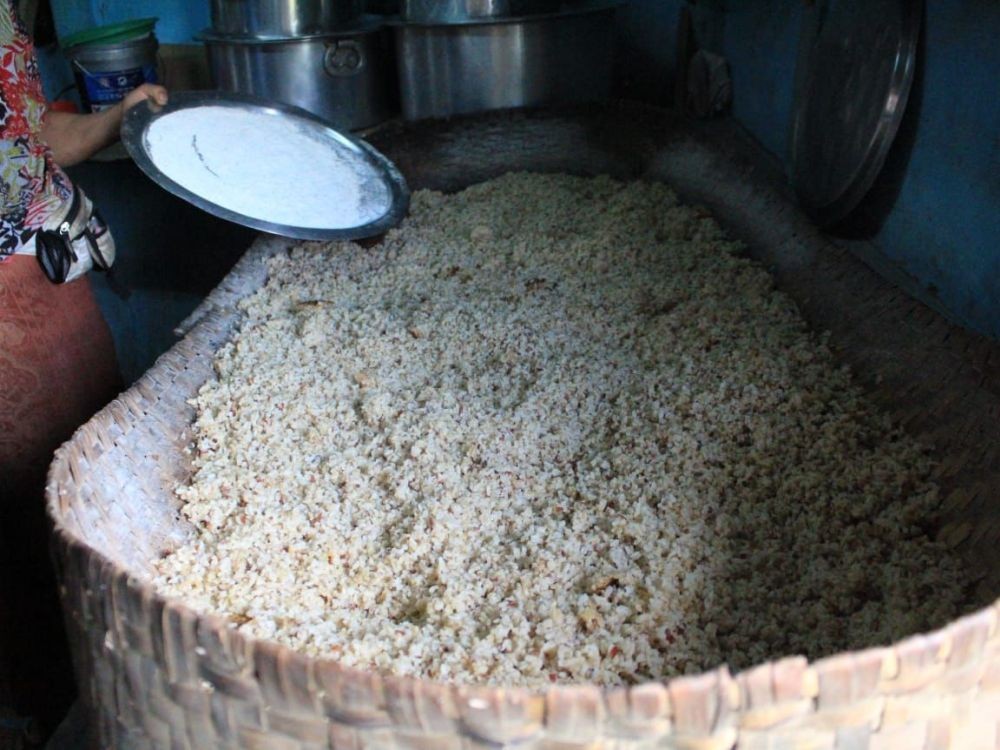Boiled rice spread on a Bamboo mat & pounded Khekhri.

Gone are the days when Zutho, Thutshe or Khe was the toast for all seasons
Ketholeno Neihu
Dimapur | June 9
Zu- a rice beer of the Angami Nagas, popularly known as Zutho, Thutshe or Khe played an important role in the socio-cultural life of the people, not only among the Angami Nagas in particular but the Nagas in general.
Its association with time, place and season, as narrated by an elder, Zhakuolie from Phesama village, can be attributed to festivals, rituals, marriages, birth or death.
“Our activities have drastically changed. Days devoted to cultivation, weaving or traditional recreations have been replaced by other modern practices,” he laments.
The process & product
Elders reminisce that during olden days, rice and the number of rice barns determined wealth. With rice being the staple food of Naga people, Zu naturally was considered a staple drink which not only became a part of the diet but was considered an important component for any calendar event.
Aleno, a woman in her 50s who brews and sells rice beer in Kohima categorizes Zu as Zutho and Thutshe which is prepared with sticky rice or kemenya (local dialect) while Khe is prepared from a particular kind of rice called Arai. A starter cake, Khekrie for Khe and Akhri for Zutho and Thutshe, which are basically sprouted rice, are used in the fermentation process, Aleno adds.
The preparation of Zutho and Thutshe which itself is an art has its own procedures. Further explaining the procedures, Aleno explains, “Sticky rice or kemenya is soaked in cold water for an hour, then drained and left to dry for the least of 2-3 hours.” Wooden pounds popularly called ‘pikhe’ in Angami dialect is used in grinding the soaked rice to fine powder which is then transferred to a ‘Litho’ or an earthen pot.
The addition of water forms a thick mixture, where the ‘Akhri’/starter cake is added. The mixture is normally left to ferment for 4- 5 days in summer and 6-7 days in winter. Zutho is the filtered liquid after addition of water and Thutshe is the filtered liquid without the addition of water after fermentation. Thutshe, between the two, is thicker, stronger and sweeter while Zutho is light, with a dull taste.
Significance
Zutho and Thutshe were considered an antidote for gaining stamina, regulating low blood pressure and ailing high fever and body weakness.
Nandita Haskar, a writer and activist in her book ‘ABC of Naga Culture’ contends that Vitamin B content in the rice beer prevented obesity as against the consumption of pork meat, a Naga favorite which contains high fat.
Zu also found its prominence in celebration and rituals. JH Hutton in the book, The Angami Nagas, describes the driving out of spirits by the terhope (local doctor) as forcing the mouth open of the terhope and putting in Zu before he communicates with the spirits.
In marriage feasts, it was customary for the bride’s relative to send off the newly married couple with sufficient brewed rice beer. A woman after labour was fed with enough Zu and flesh of the chicken. At child naming ceremonies, Zu sprinkled on the forehead was believed to cast away bad omen and malevolent spirits. In remembrance of a death man, Zu was a supplement of the thirty days of mourning on fresh leaf-cups. For a woman’s competence in marriage, it was essential to master the art of brewery just as weaving, skilled agriculture and cooking.
The brewing and consumption of Zu or traditional rice beer of the Nagas has not only diminished but attached misconceptions have also lessened its worth. Apfuo Khrienuo says her children prefer that she consume other multi-supplements rather than Zu.
Early Christian missionaries banned the local brew because of its alcoholic presence, its consideration as ‘heathen’ was preached to its converts for abstinence. Besides, western alcoholic beverages in plenty have lessened the art.






